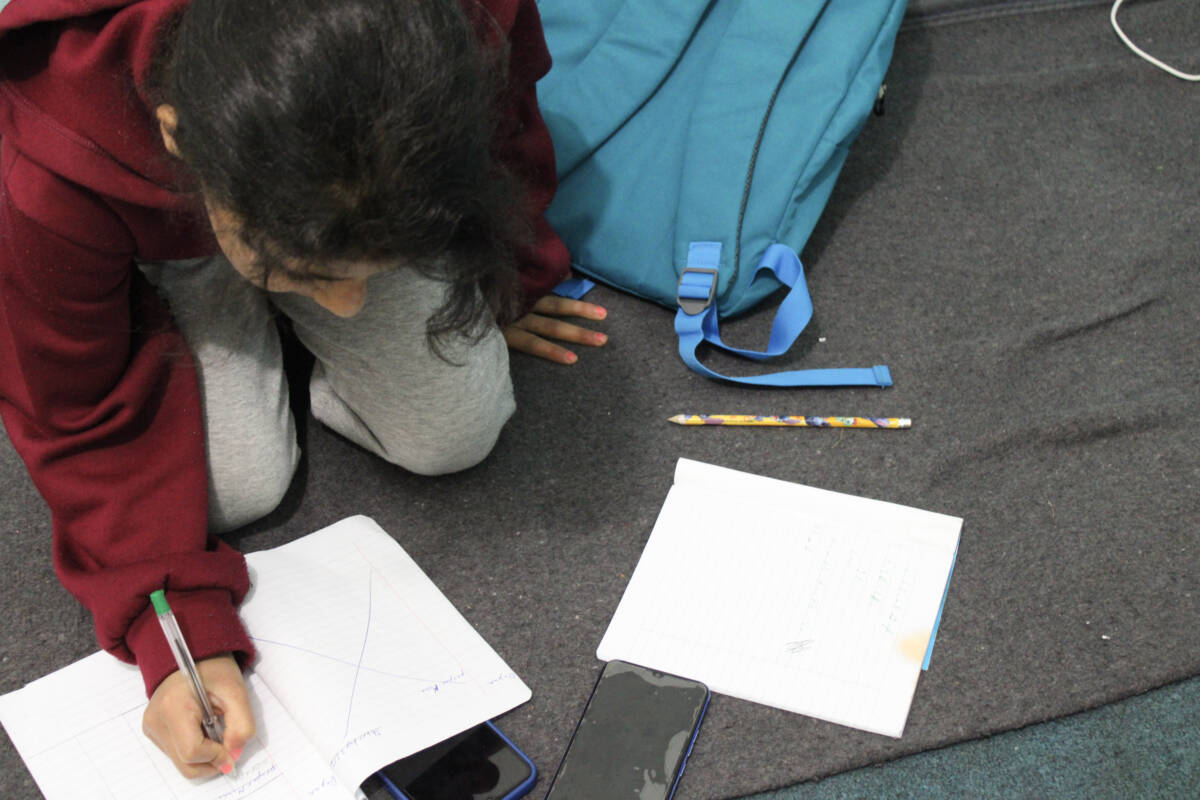Syrians fleeing Lebanon’s south struggle amid lack of support
Syrian refugees fleeing fighting between Israel and Hezbollah in southern Lebanon grapple with new challenges and a lack of support, while displacement and bombardment stirs painful memories of war in Syria.
26 January 2024
TYRE — The National School in Lebanon’s southern city of Tyre has been bustling since last October. Dozens of children play football in the courtyard and weave through the school’s narrow hallways, passing between classrooms. On the second floor, in the last classroom at the end of the hall, 12-year-old Bayan al-Jassem meticulously copies down rows of math equations.
But Bayan, like the other children, is not a student at the school. She fled here with her family of 10 in early October, a few days after fighting erupted between Hezbollah and Israel on Lebanon’s southern border. For more than 90 days, they have sheltered in this small classroom: living, sleeping and eating within the school’s confines.
“I’m scared. We don’t have a home anymore,” Bayan said.
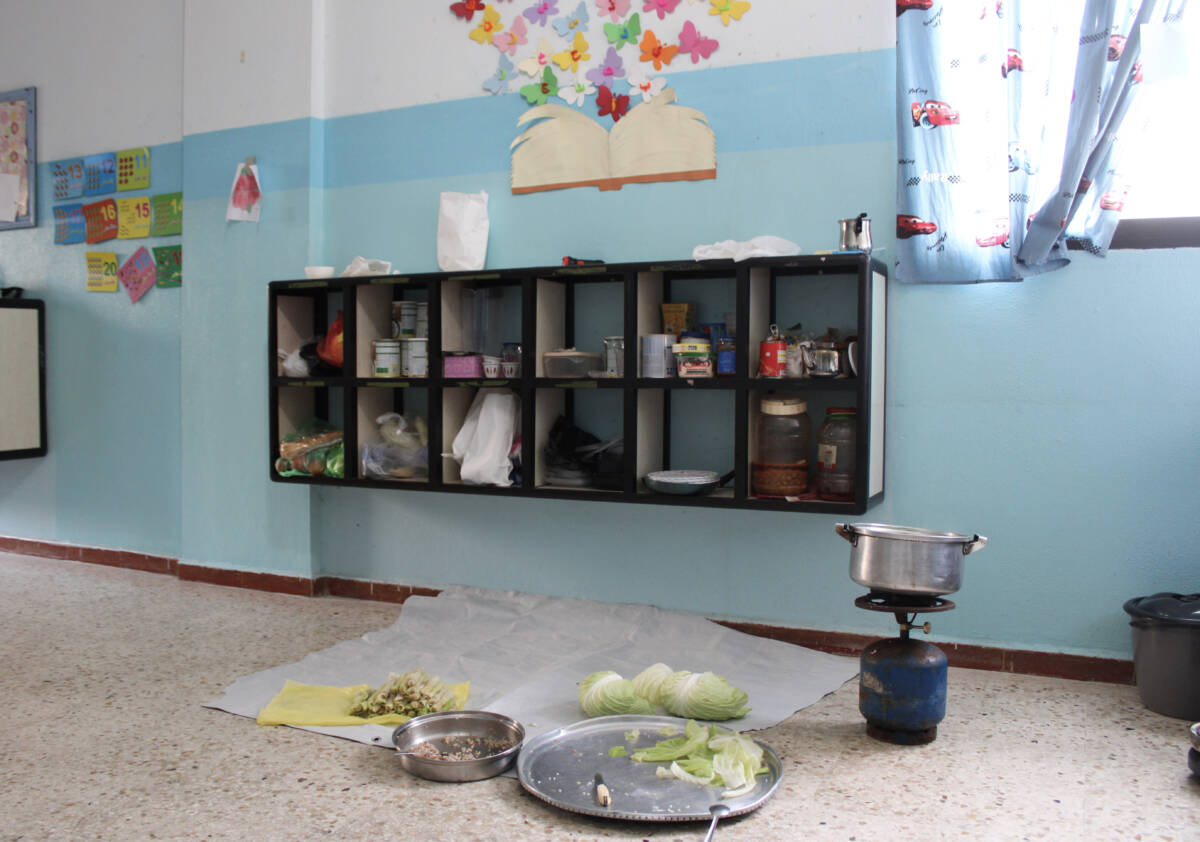
A meal of malfouf (cabbage stuffed with meat) is prepared in a classroom in the National School in Tyre, which has become a shelter for people fleeing conflict between Israel and Hezbollah in southern Lebanon, 16/01/2024 (Hanna Davis/Syria Direct)
Bayan and her family are among the more than 83,000 people displaced from Lebanon’s border areas due to ongoing violent confrontations against the backdrop of Israel’s war in Gaza. As of January 9, the Lebanese Ministry of Public Health reported a total of 135 people killed and 612 wounded by Israeli shelling and airstrikes, including at least 24 confirmed civilian deaths.
Despite her young age, Bayan has already been displaced twice. In 2018, when she was six, she and her family fled their home in Raffa, a village in Syria’s northwestern Idlib province, to escape the war. In Lebanon, they settled in the town of Bint Jbeil, around six kilometers from the Israeli border, where Bayan’s father found work in construction.
However, just six years later, the village came under Israeli shelling and airstrikes. Once again, the family hastily packed up their belongings, and moved north to Tyre in search of safety. “The war now [in Lebanon] is worse than it was in Syria,” Bayan’s father, Sheikh Naif al-Jassem, told Syria Direct. “During the war in Syria, we knew the safe spots and areas. Here, you don’t know where it is safe and where it is not.”
Before the latest fighting, nearly 90,000 Syrian refugees registered with the UN Refugee Agency (UNHCR) lived in Lebanon’s South and Nabatiyeh governorates bordering Israel, according to figures provided to Syria Direct. The agency did not have detailed information about how many of those displaced since October 2023 are Syrian.
Life was hard for Syrians in Lebanon even before the latest violence and displacement that swept up refugees and citizens alike in the south. The estimated 1.5 million Syrians in Lebanon—815,000 of whom are registered with the UNHCR—face increasingly coercive measures aimed at pushing them to return to Syria, including an ongoing, government-led deportation campaign, according to Human Rights Watch (HRW).
Read more: With all eyes on Lebanon’s south, number of Syrians leaving from northern shores spikes
Amid Lebanon’s severe economic crisis, some 90 percent of Syrian refugee households live in extreme poverty, largely due to systemic discrimination and a lack of legal residency papers—which prevents access to higher-paid jobs.
For Syrians now forced to flee airstrikes and shelling in Lebanon’s south, new challenges arising from displacement are aggravating an already dire situation.
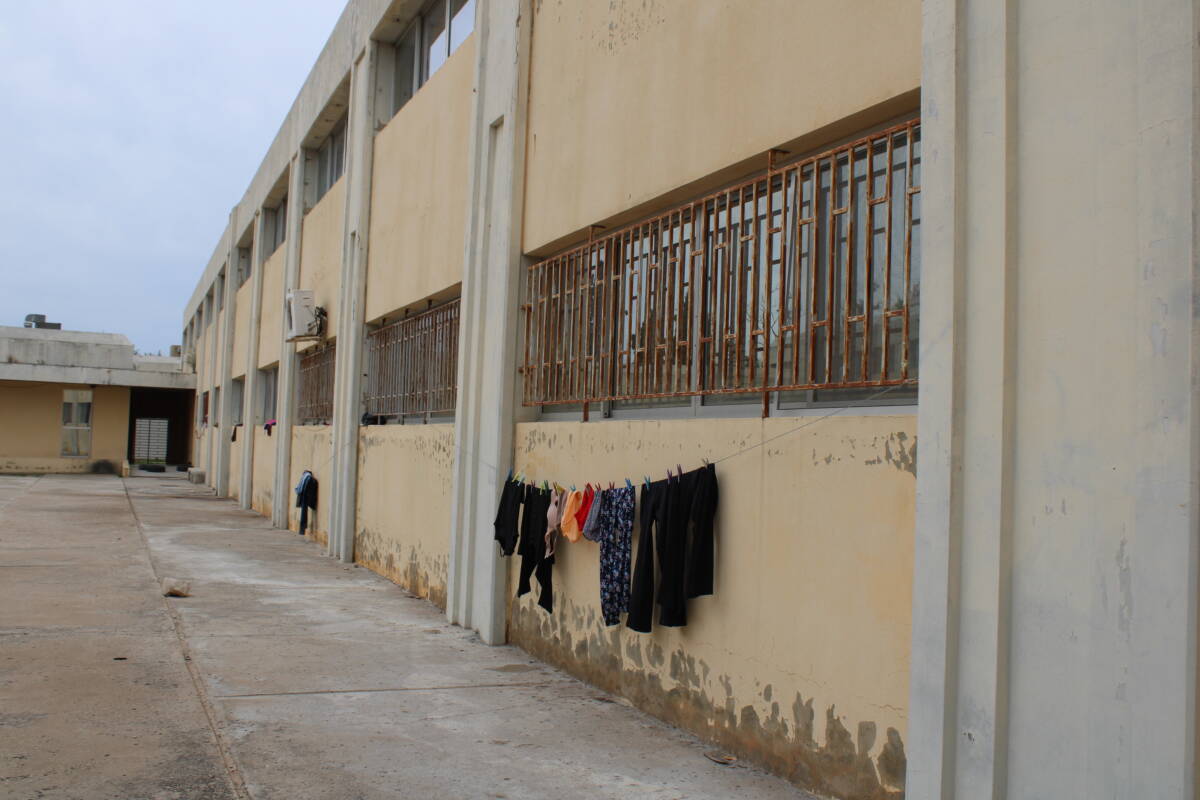
Another school in Tyre that has become a displacement shelter for people displaced from southern Lebanon by fighting between Israel and Hezbollah related to the war in Gaza, 21/12/2023 (Hanna Davis/Syria Direct)
Assistance for displaced runs short
The five displacement shelters in Tyre—including the school where Bayan and her family live—are stretched to their maximum capacity, the head of the city’s Disaster Management Union, Mortada Mhanna, told Syria Direct. Just about 20 kilometers north of the Israeli border, Tyre has seen the highest influx of internally displaced people since hostilities broke out in October.
Now, around 200 to 300 people are arriving in Tyre each day from Lebanon’s southern border. Some who first fled farther north to Beirut are also coming to Tyre, unable to afford expensive rent costs in the country’s capital. Local authorities struggle to meet growing needs.
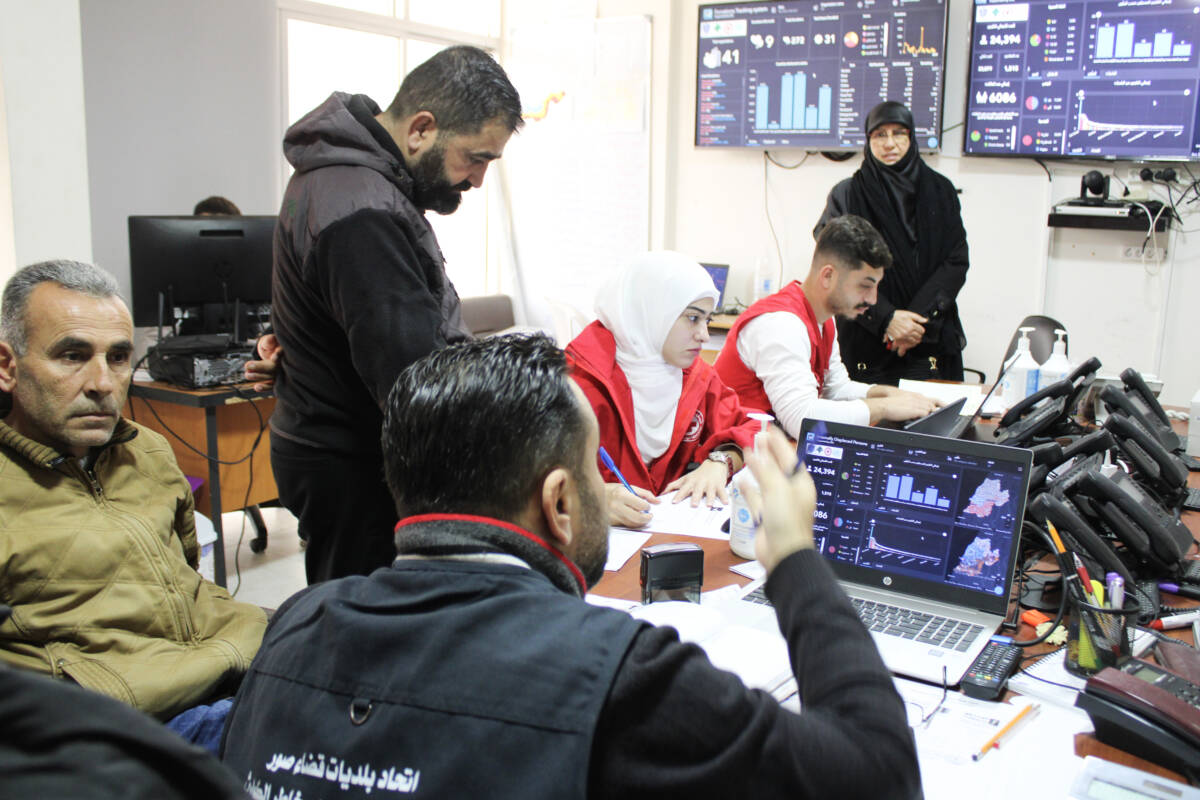
Mortada Mhanna (left of center, in black sweatshirt), the head of Tyre’s Disaster Management Union, coordinates aid distribution from his office, 16/01/2024 (Hanna Davis/Syria Direct)
There is “no difference” between Syrians and Lebanese who arrive at his office in search of assistance, Mhanna said. However, when the shelters fill up and resources stretch thin, he cannot help everyone, and Syrians are often the first to be cut off, Syria Direct observed on multiple visits to Tyre.
Mhanna coordinates aid among more than 20 local and international humanitarian organizations, which he distributes to more than 26,000 displaced people in Tyre, including around 1,000 people living in the city’s shelters. When Syria Direct visited Tyre on January 16, Mhanna said he was short on nearly 4,000 mattresses, among other supplies.
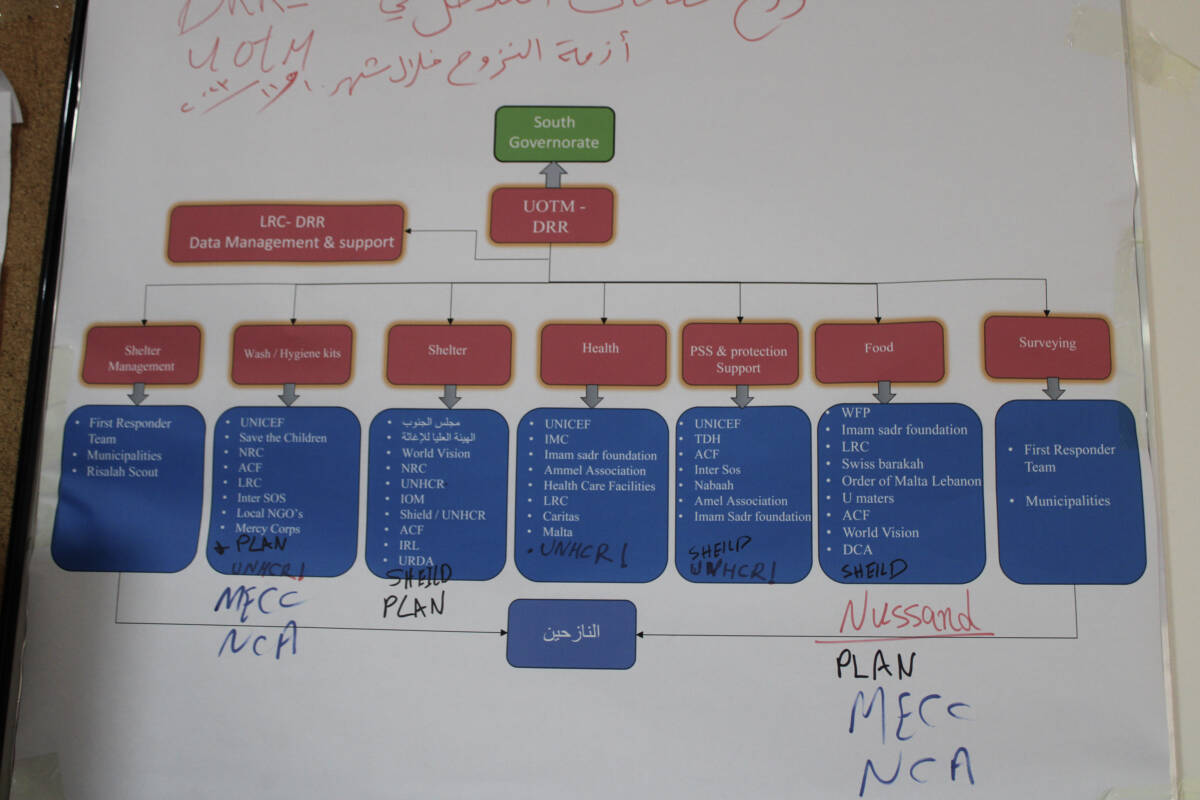
A list of humanitarian organizations providing aid in Tyre for thousands of people displaced from southern Lebanon, 16/01/2024 (Hanna Davis/Syria Direct)
Most of the aid directed towards the disaster response in southern Lebanon is in-kind assistance, distributed to Syrians and Lebanese alike. The UNHCR, the main agency that coordinates support for Syrian refugees in Lebanon, has provided mostly non-monetary support to collective shelters and displaced families in south Lebanon regardless of nationality, UNHCR Lebanon spokesperson Lisa Abou Khaled said.
In Tyre, the UN agency has provided items including 1,600 mattresses and blankets, 185 plastic sheets and 260 solar lamps since the start of the conflict, which have been distributed among the city’s shelters, she said. The UNHCR has also provided similar items to nine other displacement shelters in other parts of southern Lebanon.
However, Mhanna said support from humanitarian organizations has not kept pace with what he needs to support the rising numbers of arrivals. The UNHCR has “not significantly” supported his operations, he said.
‘Displacement adds another layer’
Just down the hall from Bayan and her family, 86-year-old Fatima Jassim al-Ramadan lies still and silent on a small mattress. She has been bedridden for nearly three months. Fatima and her family, who are also from Idlib, lived in the Lebanese border village of Aytaroun until it was caught up in the fighting.
They fled their village in mid-October, after Israel conducted an airstrike near their home, Fatima’s son, Khalaf Ahmed al-Ramadan, 34, told Syria Direct. In the chaos, Fatima fell and broke her hip.
Since the family left, Israeli bombardment has hit their building, reducing half of their apartment to rubble, al-Ramadan said. In December, Israeli airstrikes in Aytaroun reportedly destroyed an entire residential neighborhood. Like others who fled the village, al-Ramadan’s family now has no home to return to.
“We’ve been terrified, like we were during the war in Syria,” al-Ramadan said. “Our house in Syria was destroyed, and now it is in Lebanon.”
Fatima needs surgery to repair her broken hip, but her family cannot afford the $2,000 operation. They farmed tobacco in Aytaroun, but are now out of work.Without treatment, painkillers and sleep are all Fatima has had to rely on for more than three months.
Accessing healthcare in Lebanon is a challenge for Syrian refugees, and most rely on humanitarian aid to do so. Lebanon’s economic crisis, which has eroded the country’s healthcare system, has only made matters worse, Jeremy Ristord, the Doctors Without Borders (MSF) Head of Mission in Lebanon, told Syria Direct.
“Displacement adds another layer of complication to navigating where they can find healthcare, and if they can find it at all,” Ristord said. MSF operates an emergency mobile clinic in Lebanon’s Saida and Nabatiyeh governorates, although it does not currently have one in Tyre, he added.
The UNHCR covers 50-to-75 percent of the hospital costs for Syrian refugees for acute life-threatening medical conditions, UNHCR spokesperson Khaled said. Fatima’s family—who arrived in Lebanon after 2015, when the government mandated the UN agency to suspend the registration of Syrian refugees—are not registered with the UNHCR, and were not aware the agency could help with the surgery. They were also unaware of medical services other humanitarian organizations, like MSF, offer.
Ibrahim Hassan Ismail, 40, his wife and two sons are staying in the classroom next door to Fatima’s family. Ismail’s eldest son, who is four years old, has frequent nose bleeds and needs a nasal cauterization procedure to stop the bleeding, he told Syria Direct. But, like Fatima’s family, Ismail cannot afford the $3,000 surgery.
Ismail, who fled Idlib for Lebanon in 2011, is registered as a refugee with the UNHCR, but has not been able to get help from the agency, which he said “is not helping at all.” He has attempted to contact the UNHCR multiple times to get financial assistance for his son’s surgery, but received no response, he added.
Of four Syrian families Syria Direct spoke with who fled the south and were staying at the National School in Tyre, none were receiving assistance from the UNHCR. One Syrian woman said her UNHCR monthly assistance—$125 per month for her family of five—was cut on November 11, although she and her husband, who had been working as farmers, were put out of work when their land was destroyed by bombardment.
UNHCR Lebanon spokesperson Khaled responded that the agency “continues to support” refugees who have been relocated from the south with core relief items and vocational training, alongside legal, education and shelter support. The agency has also started to distribute additional cash grants to meet the needs of more than 48,700 Syrian refugees from five priority districts in the South and Nabatiyeh governorates, she added.
Ibrahim had not heard of this grant. He worked as a stonemason before the latest south Lebanon fighting, but, like many other displaced people, has been out of work for months. His financial situation has deteriorated, forcing him to continue to postpone his son’s surgery.
“Thank God for the people here [at the shelter] who are providing water and food for us, they are doing their best. But the UN should be more responsible,” Ibrahim said.
‘I want peace’
In the classroom at the end of the hall, Bayan continues to study the list of math equations, under her father’s tender gaze. He enters problems into Google Translate so he can help explain them to his daughter. He is trying to keep his children on top of their assignments, so they can return to school when the war ends, he said.
Bayan’s attempts to study are often disrupted by the sounds of warplanes flying overhead and explosions just kilometers away. When Israel flies its planes at low altitudes near the shelter, children go into a panic, grabbing their belongings and attempting to run away from the school’s compound, Moussa al-Zein, who supervises the shelter, told Syria Direct.
“They are scared of the sounds they heard in the south, which have followed them here,” al-Zein said. He worries Israel might target the school, like he has seen in reports coming out of Gaza. “God forbid, if they target this school, what can we do?”
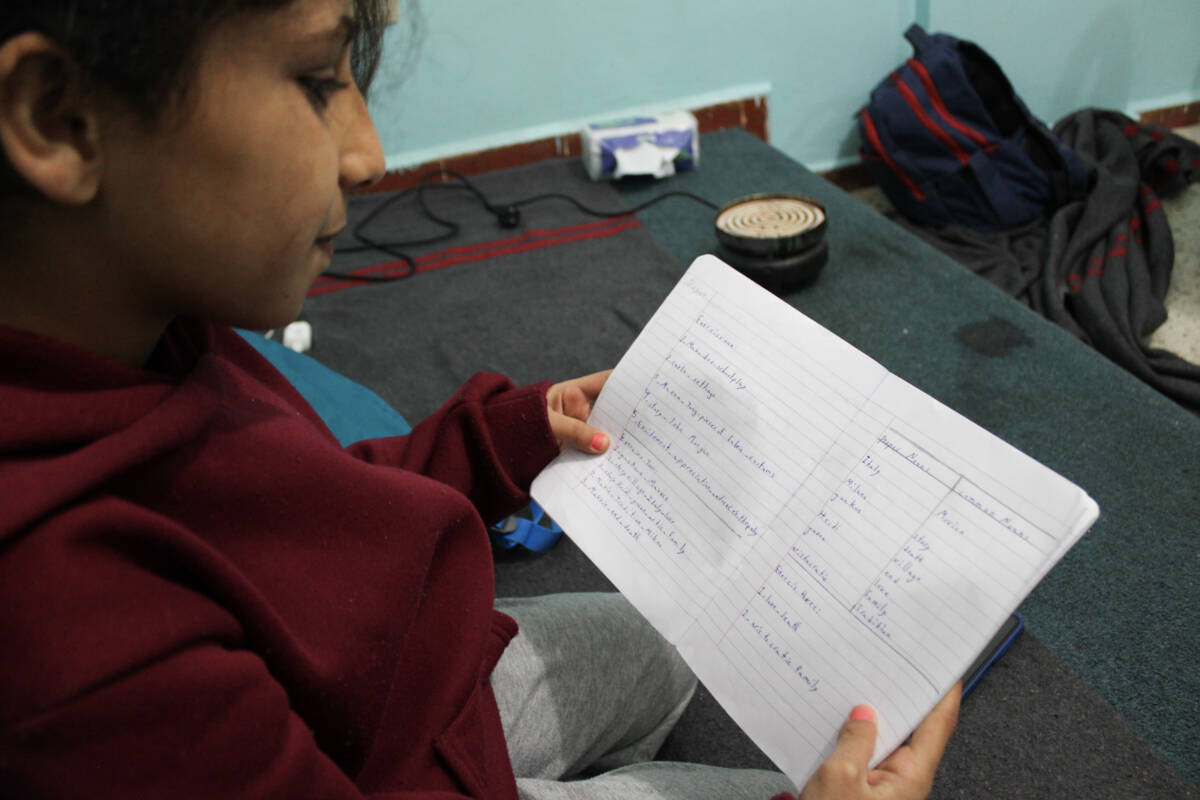
Bayan al-Jassem shows off her English notebooks in the small classroom in Tyre where she and her family have been staying for three months after they were displaced from Bint Jbeil by Israeli bombardment, 16/01/2024 (Hanna Davis/Syria Direct)
“I just want peace,” Bayan says. Math is not her favorite subject—it is English. Putting aside her equations, she proudly pulls out notebooks filled with lists of English nouns in neat handwriting.
She wants to use her English to travel. Her sights are set on Switzerland. “I want to go to Switzerland,” she says. “Where there is peace.”

